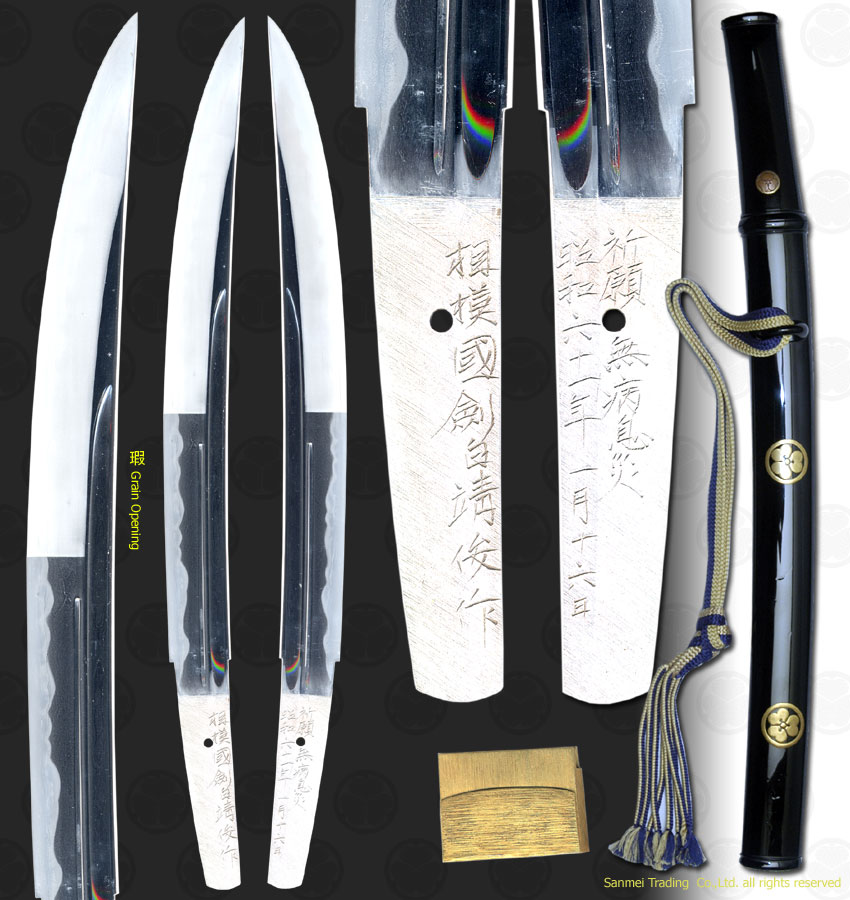Katana #84
Minamoto Yoshichika
$8,000.00
Katana signed Yoshichika in shirasaya. Furuya Sensei wrote, "Yoshichika was active in the Taisho and Showa periods, Taisho smiths are extremely rare. Yoshichika is supposedly the descendant of Sanjo Munechika, one of the earliest important smiths in the history of Japanese sword making. The famous Noh and Kabuki play, Kokaji, which is about a smith who enlists the help of the gods to produce a sword for the Emperor, is about Munechika. Yoshichika blades are noted for their cutting ability and were popular among the Imperial guards during the Taisho and early Showa periods. He was a friend of the great modern sword master, Nakayama Hakudo."
More about Yoshichika
Katana in Shirasaya.
Signature : Yoshitomi Shi Yorite Shido Minamoto Yoshichika Kore (wo) Tsukuru.
Uchiage Takesu Dotan-barai Showa 5th year 8th month hi (August 1930).
The blade was polished.
Blade length : 75.2 cm or 29.61 inches.
Sori : 3.2 cm or1.26 inches.
Mekugi : 1
Width at the hamachi :3.23 cm or 1.27 inches.
Width at the yokote: 2.25 cm or 0.89 inches.
Thickness at the hamachi: 0.81 cm or 0.32 inches.
Shape : A long shinogi-zukuri katana with plenty length and curvature modeled on a koto blade. The tang is in the form of kijimomo that the name come from the resemblance of a pheasants leg. This shape is found among the old tachis.
Horimono: Kakitoshi-bohi is carved on the both sides of the blade.
Jitetsu: Fine itame-hada. It looks like muji-fu.
Hamon: Gunome-midare.
AOI Art Certification
NBTHK Origami Certification
Katana #57
Kanebo Masatsumo with Tensho koshirae
$16,000.00
This katana was assiduously designed and assembled by Furuya Sensei to resemble an authentic tensho era sword.
Furuya Sensei wrote: "This is a very rare blade. Tensho refers to the period from 1573-1591, the end of the long period civil wars in Japan known as the Sengoku jidai. We can say this is one the earliest forms of uchi-gatana style swords, the form we commonly know as the "samurai sword" of today. Tensho mountings are very rare and highly prized by collectors and scholars today. Also, the tensho koshirae is the style of sword favored by Tokugawa Ieyasu, the first Tokugawa Shogun and the most famous example is the sword owned and warn by him."
Long sword signed Kanebo Masatsumo.
Furuya Sensei appraisal: Blade: $25,000 Koshirae: $15,000
Signature : Nanto Ju Kanabo Hyobeinojo Masatsugu.
Ura: Chikushi Kodzuke No Suke fujiwara Ason Shizukado
The blade was polished.
Blade length : 73.98 cm or 29 1/8 inches
Ubu Nakago: 2 holes.
Double gold habaki with tensho mountings.
Black lacquered saya with brown deer skin tsukamaki.
Early Goto matched menuki and kogai in shakudo with dragons clutching Vajara sword.
Early Ko-kinko kozuka with flowers in gold uttori.
Kyo-sukashi tsuba.
Shizukado is Hirokado so of Christian Daimyo Otomo Sorin
Katana #40
This is an interesting sword. It is very plain and not a long sword but not q
Furuya Sensei used to use this sword when teaching people about how to appreciate a Japanese sword.
This sword has some Paperwork but it is not NBTHK certified.
Katana #
$6,000.00
This sword is more than likely worth $10,000 today. Ono Yasutoshi is now one of the top smiths in Japan. This wakizashi has an Osoraku-zukuri construction that has close resembles to a work of Minamoto Kiyomaro. Yasutoshi - his real name is Ono Kiyoshi who lives in Sagami(Yokohama-city, Kanagawa province), born in A.D.1948. There is an insignificant dot of Kitae-hada upper Shinogi-ji on one side. The entire forging is well kneaded Itame-hada and it's pattern creates bright Kinsuji and Sunagashi in the interior of temper.
Length of cutting edge: 36.0 cm or 14.17 inches
Curvature: 0.4 cm or 0.15 inches
Width of base: 33.7 mm or 1.32 inches
Thickness of base: 6.0 mm 0.24 inches
Width of Yokote: 35.1 mm or 1.38 inches
Length of tip: 22.2 cm or 8.7 inches
Sugata (configuration): Osoraku-zukuri, mitsu-mune, Mihaba is wide leading to large point(O-kissaki).
Kitae (forging pattern): Kitae is combination of Itame-hada (wood grain) mixing in with tight ko-itame (fine wood grain) above Yokote ridge (tip).
Hamon (tempering pattern): Hamon is Notare based, large gunome. Habuchi is covered in conspicuous Nie that creates Kinsuji and sunagashi activity.
Boshi (tip): Wavy midarekomi and hakikake brushing up.
Nakago (tang): UBU (unaltered) the signature on the hakiomote is chiselled Sagami-koku Kenpaku YASUTOSHI-saku and ura is marked Kigan Mubyou-Sokusai (pray be in sound health) and dated Showa rokujuichi-nen Ichigatsu Ju-roku-nichi (in the 16th day in January 1986).
Bohi and Soehi grooves on both sides.
Black lacquered Aikuchi koshirae fittting shows some marks of hollows.
Katabami-mon Makie crest.
Gold double habaki collar.


